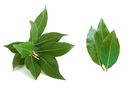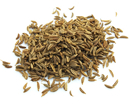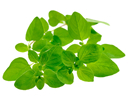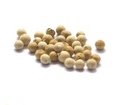Untitled Document

|
Herbs & Spices Foods in Germany are rarely spicy or heavily seasoned. Likewise, garlic does not play much of a roll in traditional German cooking, although the more modern recipes are beginning to use it.
The following herbs and spices are commonly used in German cuisine. |
| |
| Bay Leaves (Lorbeerblätter) |
 |
Bay leaves have a savory, slightly bitter taste.Their fragrance is herbal and slightly floral. They are used both fresh and dried, although fresh bay leaves are hard to find. Bay leaves add depth and richness to foods. They are most often added to soups, stews, casseroles, roasts, and other long-cooking dishes. They are usually added whole, then removed before the dish is served. Bay leaves should be used sparingly as they are very potent.
Photo: © eAlisa - Fotolia.com |
|
| |
| |
| Borage (Borretsch, Gurkenkraut) |
 |
Borage leaves are oval, light to medium green, and are covered with fuzzy bristles. The leaves can get quite large - up to 6 inches in length. Their taste and aroma are similar to fresh cucumbers, which is why it is also known in Germany as Gurkenkraut (Cucumber Herb). Borage leaves are most often used fresh in salads and dips. It is also an ingredient in Frankfurter Grüne Sosse. It is also mixed into butter, with other herbs, to make herb butter and herb-quark. Borage blooms, small blue flowers, are also edible and are often added to salads as decoration.
Photo: © silencefoto - Fotolia.com |
|
| |
| |
| Caraway Seeds (Kümmel) |
 |
Caraway is a member of the parsley family. Although they are called "seeds", caraway seeds are actually the small fruit of the caraway plant. They are sweet yet strong and have a taste similar to anise. Caraway seeds are most often added to cabbage dishes (especially Sauerkraut), sauces, quark, meat dishes, breads, and potato dishes.
Photo: © Dionisvera - Fotolia.com |
|
| |
| |
| Chives (Schnittlauch) |
 |
Chives belong to the same family as onions. They have leafless stems that end in a cluster of tiny flowers. Although the flowers are edible, most often just the stems are used. The stems have a mild onion flavor. The stems are finely chopped and are added fresh to salads, potato dishes (especially potato salad), sauces, soups, meat dishes, and egg dishes. It is also mixed into butter, with other herbs, to make herb butter and herb-quark. Chives should not be cooked, so if adding to warm dishes, add just before serving.
Photo: © sundebo - Fotolia.com |
|
| |
| |
| Dill |
 |
Dill leaves (also known as "dill weed") have a strong, fresh, grassy taste. Fresh dill is more flavorful than dried dill. Dill loses its flavor when heated, so on warm dishes dill is added just before being served. Dill is most often used to fresh salads (especially cucumbers and tomatoes), fish and seafood dishes, and vegetable dishes. It is also mixed into butter, with other herbs, to make herb butter and herb-quark.
Dill seeds have a more intense flavor, similar to a combination of anise and celery. These are used in breads, stews, vegetable dishes and in the making of pickles.
Photo: © Marén Wischnewski - Fotolia.com |
|
| |
| |
| Juniper Berries (Wacholderbeere) |
 |
Juniper berries are the dried fruits of the juniper shrub. They are slightly sweet, spicy, and bitter. The berries can be used whole or ground. Whole berries cooked in recipes should be mashed before serving. Juniper berries are most often added to game, Sauerkraut, marinades, spicy roasts and casseroles. They are also used in pickling.
Photo: © eyewave - Fotolia.com
|
|
| |
| |
| Marjoram (Majoran, Wurstkraut ) |
 |
Marjoram leaves are tangy, savory, aromatic, and slightly bitter. The leaves are used fresh or dried. Majoram is also known as Wurstkraut because it is most frequently used in making wurst (sausages). It is also added to potato dishes (such as potato soup and potato dumplings), sauces, soups, and legumes.
Photo: © kab-vision - Fotolia.com |
|
| |
| |
| Parsley (Petersilie) |
 |
Parsley leaves are dark green and are fresh, flavorful, and slightly bitter. There are two types of parsley. Flat leaf parsley has smoother, flatter leaves than the curly leaf parsley, which has more crinkled leaves. Flat leaf parsley has a more intense flavor.
Parsley serves as both a flavoring agent as well as a decoration. It is added to soups, stews, salads, dressings, and Frankfurter Grüne Sosse. It is also mixed into butter, with other herbs, to make herb butter and herb-quark. Parsley is most often used raw and finely chopped. It may be slightly cooked, but it loses its aroma when it is heated.
Photo: © Corinna Gissemann - Fotolia.com |
|
| |
| |
| Thyme (Thymian) |
 |
Thyme leaves are elongated, oval, and dark green. Their stems are short, green, and woody. Both fresh and dried thyme are used - both blend well with other herbs and spices. It is most often added to roasts and spicy meat dishes, as well as to soups and salads.
Photo: © womue - Fotolia.com |
|
| |
| |
| White Pepper (Weisser Pfeffer) |
 |
White pepper comes from the fully ripened peppercorn. In contrast, black pepper comes from peppercorn that is picked when still green and dried in the sun until it turns black. White pepper is less hot and aromatic than black pepper. Pepper is added to almost every dish that also has salt, as the two seasonings compliment each other very well.
Photo: © Irina Solatges - Fotolia.com |
| |
|
|
|
|

